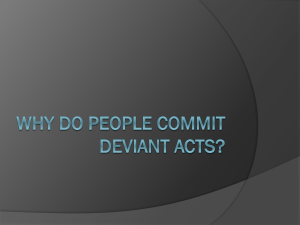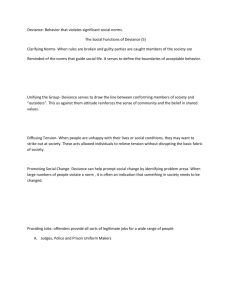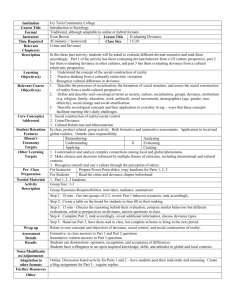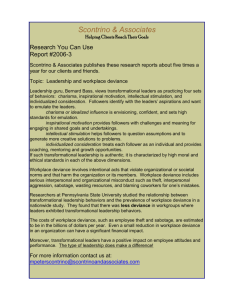Deviant Behavior - John Jay College of Criminal Justice
advertisement
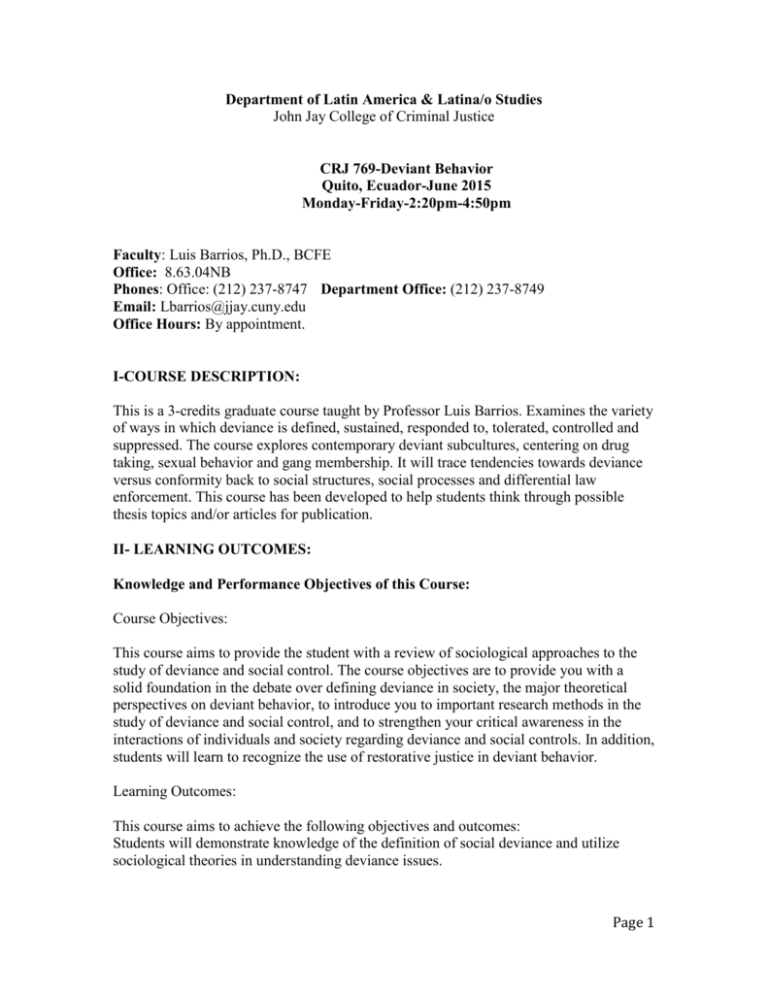
Department of Latin America & Latina/o Studies John Jay College of Criminal Justice CRJ 769-Deviant Behavior Quito, Ecuador-June 2015 Monday-Friday-2:20pm-4:50pm Faculty: Luis Barrios, Ph.D., BCFE Office: 8.63.04NB Phones: Office: (212) 237-8747 Department Office: (212) 237-8749 Email: Lbarrios@jjay.cuny.edu Office Hours: By appointment. I-COURSE DESCRIPTION: This is a 3-credits graduate course taught by Professor Luis Barrios. Examines the variety of ways in which deviance is defined, sustained, responded to, tolerated, controlled and suppressed. The course explores contemporary deviant subcultures, centering on drug taking, sexual behavior and gang membership. It will trace tendencies towards deviance versus conformity back to social structures, social processes and differential law enforcement. This course has been developed to help students think through possible thesis topics and/or articles for publication. II- LEARNING OUTCOMES: Knowledge and Performance Objectives of this Course: Course Objectives: This course aims to provide the student with a review of sociological approaches to the study of deviance and social control. The course objectives are to provide you with a solid foundation in the debate over defining deviance in society, the major theoretical perspectives on deviant behavior, to introduce you to important research methods in the study of deviance and social control, and to strengthen your critical awareness in the interactions of individuals and society regarding deviance and social controls. In addition, students will learn to recognize the use of restorative justice in deviant behavior. Learning Outcomes: This course aims to achieve the following objectives and outcomes: Students will demonstrate knowledge of the definition of social deviance and utilize sociological theories in understanding deviance issues. Page 1 Students will demonstrate knowledge of the major forms of deviance in society. Students will develop a scientific understanding of deviance and identify appropriate methodologies associated by thinking and writing critically about the subject matter. III- TEACHING PHILOSOPHY OF THIS COURSE AND CLASSROOM PEDAGOGY: Five specific quotations capture core elements of my approach to teaching: 1- Most teachers teach facts, good teachers teach ideas, great teachers teach how to think. Jonathan Pool 2- It is absolutely essential that the oppressed participate in the revolutionary process with an increasingly critical awareness of their role as subjects of the transformation. Paulo Freire 3-Critical pedagogy needs to establish a project of emancipation that moves beyond simply wringing concessions from existing capitalist structures and institutions. Rather, it must be centered around the transformation of property relations and the creation of a just system of appropriation and distribution of social wealth. Peter McLaren 4-True peace is not merely the absence of tension; it is the presence of justice. Martin Luther King 5-The hottest places in hell are reserved for those who, in times of great moral crisis, maintain their neutrality. Dante IV-CONTRACT GRADING SYSTEM: 1-Active Class Participation: Students are expected to attend each class, complete readings and assignments on time, and to contribute towards discussions. This is a graduate level course and students are expected to be creative in their thinking and presentations. 2-Summaries: You will write four 1-2 page summary papers (single-spaced) covering each of the following thematic questions: 1) why people deviate; 2) social constructions of deviance; 3) conflict/critical theory; and 4) resistance challenging deviance/crime. Each paper will incorporate insights from the relevant readings/discussions of the given theme. You will want to think about all the material of a given topic and what they “say” as a whole. You will be graded on concision, grammar/style, accuracy, complexity, and clarity. These will be due at the end of each week. For example: June 5, 12, 19, & 26. Page 2 3-Journals: You will be responsible for finding two (2) recent (preferably within the last two years) academic journal articles that address restorative justice and deviant behavior. You will brief the article using the template that is in this syllabus (page 7). When reading the articles, do not get lost in the statistical analysis since the authors may be using a procedure with which you are not familiar. Particularly focus on the initial problem being studied, hypotheses, research questions, and conclusions. These article summaries are to be submitted as a journal of critiques that are typed on plain paper and stapled for submission. Recommendation: Print the articles before travelling to Ecuador. Articles due: Friday, June 26, 2014. 4-Class Presentation: I would like everyone in the class to have an opportunity to make a 30 minute presentation on one of the following topic: Community Justice. You will be graded on the quality of your presentation. I’d recommend incorporating music, video, or PowerPoint, but it is not required. Video clips cannot make up more than 5 minutes of your presentation. 5-Final paper: For this class you will submit one 15-20 page paper (not including references) and this paper is an extension of your class presentation. The paper is to be in the form of a literature review. You will use your journal articles and class readings to help build the paper, but you will probably need more than the required articles to synthesize the literature of the specific topic. The purpose of this writing assignment is to help strengthen social scientific skills, develop critical thinking tools, and expose you to sociological research. All of which are useful outside of the classroom. Each paper will be evaluated based on the following criteria: Organization: an introduction explaining your topic and what it is you plan on doing in your paper (on the first page), a thorough review of relevant literature on your topic, a discussion of the methods with which you used to collect your data, a discussion of your findings and criticisms, and a summary tying everything together and stating how your findings fit with the literature you read on your topic. Narrative structure: you will want to construct a clear, concise and logical argument that flows from one idea to the next. Make sure you use your concepts correctly; demonstrate a health use of you sociological imagination, and support your claims/statements with your data. Page 3 Is your paper clean and polished, free of grammatical mistakes, proof-read, page numbers, clear and direct title, minimum number of (scholarly) references, proper and consistent format. Doing well on these papers will take some time, so please start early. Late papers will be deducted 1/3 letter grade per class period overdue. I will only accept papers up to two class periods late and only if you checked with me first. Paper due: July 24, 2015. Your grade will be determined by the following scale: Class participation Summaries Two (2) journals template (10 points each) Class presentation Final paper Total 15% 20% 20% 15% 30% 100% V-READINGS: Texts Botherton, D. C. and Barrios, L. (2011). Banished to the Homeland: Dominican Deportees and Their Stories of Exile. New York, NY: Columbia University Press. ISBN-10: 0231149344 Thio, A.D., Taylor, J.D. & Schwartz. (2012). Deviant Behavior, 11 edition. New York: Pearson. ISBN-10: 020520516X Journals: You will be responsible for two (2) recent (preferably within the last five years) professional sociological journal articles that address the following topic: Restorative Justice & Harm Reduction. When reading the articles, do not get lost in the statistical analysis since the authors may be using a procedure with which you are not familiar. Particularly focus on the initial problem being studied, hypotheses, and conclusions. These article summaries are to be submitted as a journal of critiques that are typed on plain paper and stapled for submission. Print the articles before travelling to Ecuador. VI-COURSE OUTLINE AND READINGS: Page 4 Week One Introduction to the course and task assignments: Radical criminology, Marxist method, and theories of deviant behavior. 1. What Is Deviant Behavior? 2. Positivist Theories. 3. Constructionist Theories. 4. Physical Violence. 5. Rape and Child Molestation. 6. Family Violence. 7. Social Control and the Immigrant Readings: Thio, Taylor, & Schwartz: Chapters 1, 2 & 3 Brotherton & Barrios: Chapters 1-3 Week Two Radical criminology, Marxist method, self-destructive deviance, & diverse lifestyles and deportations. First Reaction Paper Due 7. Suicide. 8. Mental Disorder. 9. Heterosexual Deviance. 10. Gays and Other Victims of Stigma. 11. Social Exclusion, Crime Control, and the Contradictions of Late Modernity Readings: Thio, Taylor, & Schwartz: Chapters 4, 5 & 6 Brotherton & Barrios: Chapters 4-6 Week Three Drugs use and inequality in deviance Second Reaction Paper Due 11. Drug Use. 12. Drinking and Alcoholism. 13. Privileged Deviance. 14. Underprivileged Deviance. 15. Experiencing the Legal Process of Deportation 16. The Experience of Social Displacement and Stigmatization Readings: Thio, Taylor, & Schwartz: Chapters 7, 8, 9 & 10 Brotherton & Barrios: Chapters 7-9 Page 5 Week Four Bringing It Together: Wild frontier and deportations Third Reaction Paper Due 15. Internet Deviance -Personal Reflections -Discussion of Field Notes -Writing Workshops -Review of Course -Preparation for Final Presentations at John Jay College 16. What of Resistance? Readings: Thio, Taylor, & Schwartz: Chapters 11, 12, 13 & 14 Brotherton & Barrios: Chapters 10-12 Page 6 Template for Analyzing the Logic of an Article Take an article that you have been assigned to read for class, completing the “logic” of it using the template below. This template can be modified for analyzing the logic of a chapter in a textbook. 1-The Logic of “(name of the article)” 2-The main purpose of this article is __________________________________ (State as accurately as possible the author’s purpose for writing the article) 3-The key question that the author is addressing is _______________________ (Figure out the key question in the mind of the author when s/he wrote the article.) 4-The most important information in this article is ________________________ (Figure out the facts, experiences, data the author is using to support her/his conclusions.) 5-The main inferences/conclusions in this article are ________________________. (Identify the key conclusion the author comes to and presents in the article.) 6-The key concept(s) we need to understand in this article is (are) ___________________ _______________________. By these concepts the author means ________________ _______________________. (Figure out the most important ideas you would have to understand in order to understand the author’s line of reasoning.) 7-The main assumption(s) underlying the author’s thinking is (are) ___________________ _______________________. (Figure out what the author is taking for granted [that might be questioned].) 8-If we take this line of reasoning seriously, the implications __________________________ _______________________. (What consequences are likely follow if people take the author’s line of reasoning seriously?) 9-The main point(s) of view presented in this article is (are) ________________________. (What is the author looking at, and how is s/he seeing it?) Copyright 2001 Foundation for Critical Thinking www.criticalthinking.org The Problem of Egocentric Thinking Page 7 Egocentric thinking comes from the unfortunate fact that humans do not naturally consider the rights and needs of others, nor do we naturally appreciate the point of view of others or the limitations in our own point of view. We become explicitly aware of our egocentric thinking only if trained to do so. We do not naturally recognize our egocentric assumptions, the egocentric way we use information, the egocentric way we interpret data, the source of our egocentric concepts and ideas, the implications of our egocentric thought. We do not naturally recognize our self-serving perspective. As humans we live with the unrealistic but confident sense that we have fundamentally figured out the way things actually are, and that we have done this objectively. We naturally believe in our intuitive perceptions-however inaccurate. Instead of using intellectual standings in thinking, we often use self-centered psychological (rather than intellectual) standards to determine what to believe and what to believe and what to reject. Here are the most commonly used psychological standards in human thinking. “IT’S TRUE BECAUSE I BELIEVE IT.” Innate egocentrism: I assume that what I believe is true even though I have never questioned the basis for many of my beliefs. “IT’S TRUE BECAUSE WE BELIEVE IT.” Innate sociocentrism: I assume that the dominate beliefs within the groups to which I belong are true even though I have never questioned the basis for many of these beliefs. “IT’S TRUE BECAUSE I WANT TO BELIEVE IT.” Innate wish fulfillment: I believe in, for example, accounts of behavior that put me (or the groups to which I belong) in a positive rather than a negative light even though I have not seriously considered the evidence for the more negative light even though I have not seriously considered the evidence for the more negative account. I believe what “feels good.” What supports my other beliefs, what does not require me to change my thinking in any significant way, what does not require me to admit I have been wrong. “IT’S TRUE BECAUSE I HAVE ALWAYS BELIEVED IT.” Innate self-validation: I have a strong desire to maintain beliefs that I have long held, even though I have not seriously considered the extent to which those beliefs are justified, given the evidence. “IT’S TRUE BECAUSE IT IS IN MY SELFISH INTEREST TO BELIEVE IT.” Innate selfishness: I hold fast to beliefs that justify my getting more power, money, or personal advantage even though these beliefs are not grounded in sound reasoning or evidence. Since humans are naturally prone to assess thinking in keeping with the above criteria, it is not surprising that we, as a species, have not developed a significant interest in establishing and teaching legitimate intellectually standards. It is not surprising that our thinking is often flawed. We are truly the “self-deceived animal.” The Following Policy Applies to this Course: Page 8 Attendance: The success of a seminar depends on the participants’ investment of themselves in every aspect of that seminar. It is essential that you attend every class and that you come prepared to participate fully. Excessive absence is cause for failure in this course. Tardiness: Everyone knows how a latecomer can disrupt a class by distracting students and instructors causing them to lose their train of thought. However, everyone can have a difficult day that makes it impossible to be on time for class. Therefore, you have a grace period of two tardy days. Being late three times will constitute an absence. Late papers: Late papers or projects will not be accepted except in extraordinary circumstances. College Policy on Plagiarism: Plagiarism is the presentation of someone else's ideas, words, or artistic, scientific, or technical work as one's own creation. Using the ideas or work of another is permissible only when the original author is identified. Paraphrasing and summarizing, as well as direct quotations, require citations to the original source. Plagiarism may be intentional or unintentional. Lack of dishonest intent does not necessarily absolve a student of responsibility for plagiarism. It is the student's responsibility to recognize the difference between statements that are common knowledge (which do not require documentation) and restatements of the ideas of others. Paraphrasing, summarizing, and direct quotation are acceptable forms of restatement, as long as the source is cited. Students who are unsure how and when to provide documentation are advised to consult with their instructors. The Library has free guides designed to help students with problems of documentation. College Policy on Cheating: Students are prohibited from using books, notes, and other reference materials during examinations except as specifically authorized by the instructor. Students may not copy other students' examination papers, have others take examinations for them, substitute examination booklets, submit papers written by others, or engage in other forms of academic dishonesty. An instructor who determines that such violation has occurred may follow the options stated below. Resolving Allegations of Cheating and Plagiarism: Allegations of cheating may be referred to the Vice President for Student Development to be handled under the Student Disciplinary Procedures in Article 15 of the Bylaws of the CUNY Board of Trustees, copies of which are available in the Library. Plagiarism may be either an academic infraction or a disciplinary infraction depending on the nature of the allegation. The key factor in determining whether an allegation of plagiarism should be treated as an academic or disciplinary matter is whether resolution of the issues involves primarily a question of fact or primarily a question of professional academic judgment (i.e., a judgment involving the professor's expertise, or a subjective evaluation of the student's work product, or both). For example, whether a student did, in fact, plagiarize from another source frequently involves primarily a question of fact. In such circumstances, Page 9 the matter may be referred to the Vice President for Student Development for the initiation of a disciplinary hearing. However, the primary issue in a plagiarism case frequently is whether the ideas and/or language expressed by a student were original or were the ideas of another. In such cases, the matter is more properly characterized as academic, for which the faculty member should award a a grade appropriate to the circumstances. Sometimes, whether a question of fact or an academic judgment is at issue is not clear. When a faculty member is not certain whether a particular case of plagiarism ought to be treated as a disciplinary infraction or an academic infraction, the faculty member should consult with the Vice President for Student Development. If the Vice President determines that the matter is disciplinary, the matter will be handled as a disciplinary violation under Article 15 of the Bylaws of the Board of Trustees, If it is determined that the matter is academic, the Vice President will refer the matter back to the faculty member, and the College's established procedures in terms of grading and appeals will be followed. In some instances of plagiarism, a faculty member may wish to impose a grade reduction penalty to a student as well as seek the imposition of one of the penalties that may be authorized only by a disciplinary committee convened pursuant to Article 15 of the Bylaws, such as disciplinary probation, long term suspension, or exclusion. Where the faculty member refers a case to the Vice President for Student Development for referral to a Judicial Committee, the faculty member must hold the grade in abeyance until the Judicial Committee has determined whether the student is guilty or innocent of the charges. After the Judicial Committee has rendered its decision, a grade that is consistent with the findings of the committee may be awarded by the faculty member. Student Appeals in Questions of Academic Honesty: If a student has been penalized for cheating or plagiarizing, he or she has a right to appeal an academic sanction to the Judicial Committee. Appeals are made through the Vice President for Student Development. Generally, such appeals are filed on the issues of whether (a) plagiarism did in fact occur; and/or (b) the imposition of such sanction is grossly disproportionate to the offense involved. A presumption strongly favoring proportionality shall attach to the appeal and the burden of proof lies with the student. In the case of the imposition of disciplinary sanctions, the appropriate rules, regulations and bylaws of the Board of Trustees concerning student discipline are followed. Appeals regarding disciplinary sanctions imposed by the Judicial Committee can be made to the President of the College. Page 10


